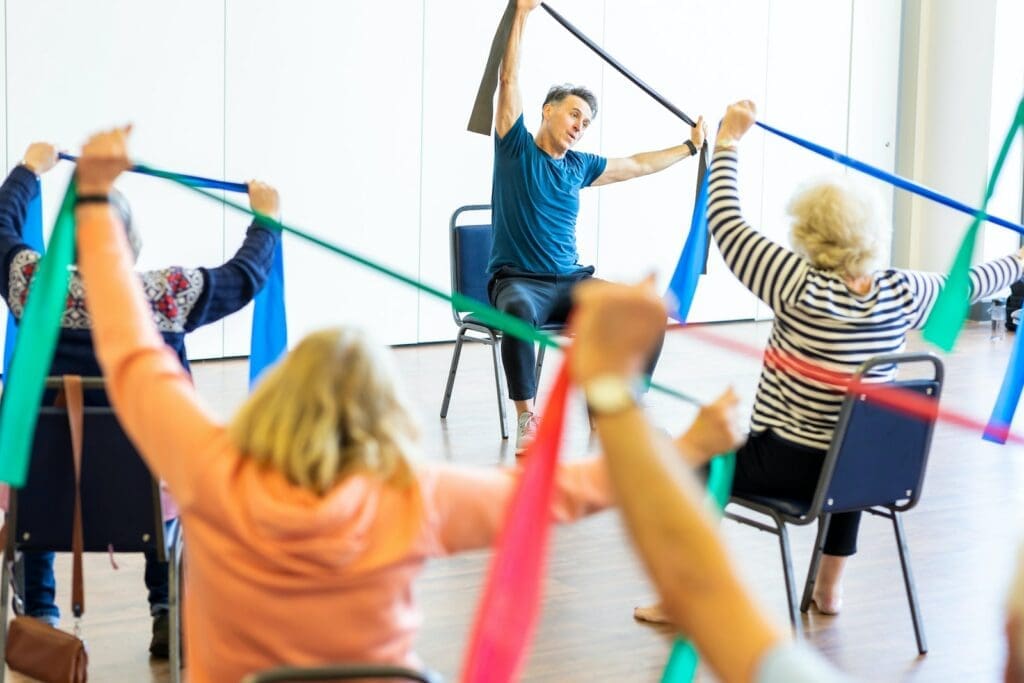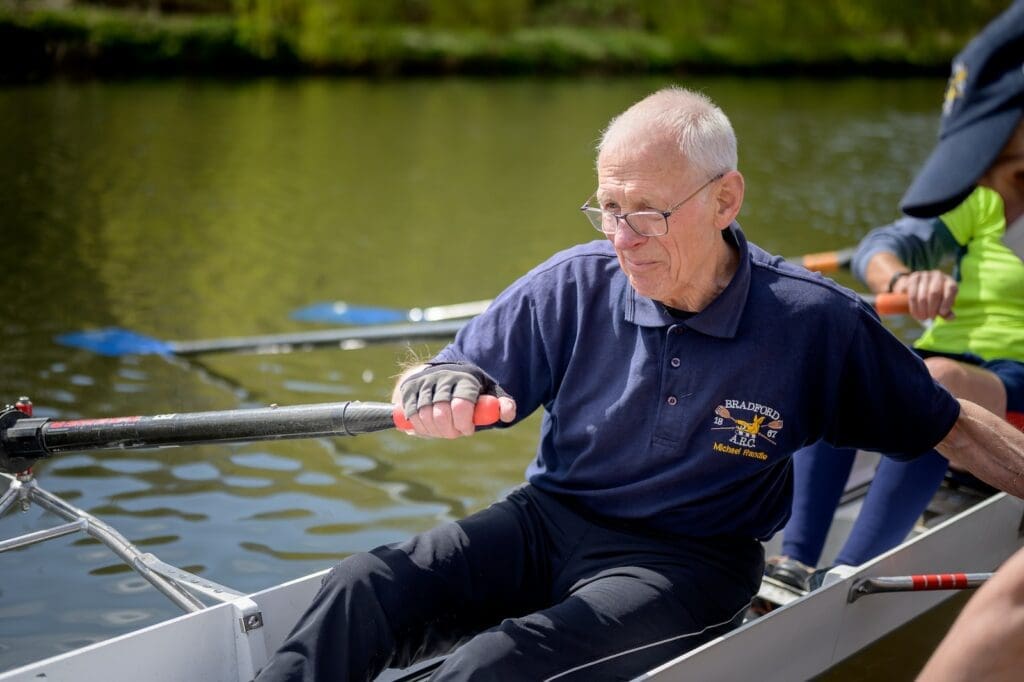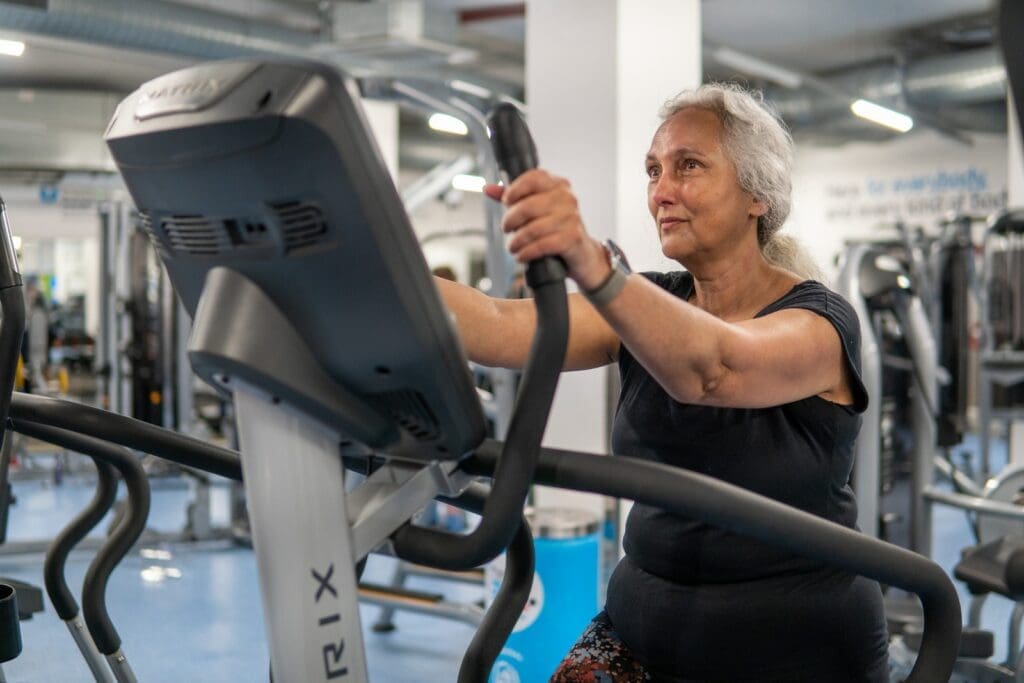
Expert Tips and Guidelines
As people age, it becomes increasingly important to maintain a healthy lifestyle. This includes regular exercise and a balanced diet. For seniors over the age of 60, it can be challenging to establish a fitness routine that is safe, effective, and enjoyable. However, with the right guidance and resources, it is possible to maintain a healthy and active lifestyle well into your golden years.
One of the most significant benefits of regular exercise for seniors is improved mobility and balance. As we age, our muscles and joints become less flexible, making it more challenging to move around comfortably. However, by engaging in strength and balance training exercises, seniors can improve their overall mobility and reduce the risk of falls and injuries. Additionally, regular exercise can help seniors maintain a healthy weight, reduce the risk of chronic diseases such as diabetes and heart disease, and improve mental health and cognitive function.
In this article, we will explore some of the best health and fitness routines for seniors over 60. We will provide guidance on how to establish a safe and effective exercise routine, including tips for getting started, choosing the right types of exercise, and avoiding injury. We will also discuss the importance of a balanced diet and provide some tips for healthy eating habits for seniors.
Understanding the Importance of Health and Fitness for Seniors
Maintaining good health and fitness is essential for seniors over 60. As people age, their bodies undergo various changes that can affect their overall health and well-being. Regular exercise and a healthy diet can improve physical and mental health, reduce the risk of chronic diseases, and increase independence.
Aging can lead to a decrease in muscle mass and bone density, which can increase the risk of falls and fractures. Regular exercise, such as strength training and balance exercises, can help seniors maintain muscle mass and improve balance, reducing the risk of falls and injuries.
Seniors who engage in regular physical activity can also reduce their risk of chronic diseases such as type 2 diabetes, heart disease, and certain cancers. Exercise can also improve cardiovascular health, reduce blood pressure, and lower cholesterol levels.
In addition to physical health benefits, exercise can also improve mental health. Regular physical activity can reduce symptoms of depression and anxiety, improve cognitive function, and increase overall feelings of well-being.
Maintaining a healthy diet is also important for seniors. A balanced diet that includes plenty of fruits, vegetables, whole grains, and lean proteins can provide essential nutrients and reduce the risk of chronic diseases.
By maintaining good health and fitness, seniors can increase their independence and quality of life. Regular exercise and a healthy diet can help seniors maintain their ability to perform daily activities and reduce the need for assistance or medical care.
Overall, understanding the importance of health and fitness for seniors over 60 is crucial for maintaining good health and well-being. By engaging in regular exercise and maintaining a healthy diet, seniors can improve their physical and mental health, reduce the risk of chronic diseases, and increase independence.
Starting with Walking
Walking is a great way for seniors over 60 to start their fitness journey. It is a low-impact exercise that can be done at any time of the day and does not require any special equipment. According to a study published in JAMA Internal Medicine, walking every day can provide greater longevity and help seniors live a longer life.
To start a walking routine, seniors should begin with a 5 to 10-minute walk and gradually increase the duration by 5-minute increments until they reach 30 minutes a day. Seniors should aim to walk at a moderate pace, where they can still carry on a conversation but feel slightly out of breath.
Seniors can incorporate walking into their daily routine by taking the stairs instead of the elevator, walking to the store instead of driving, or taking a stroll after dinner. It is important to wear comfortable shoes and clothing, stay hydrated, and pay attention to any discomfort or pain while walking.
In addition to improving cardiovascular health and joint mobility, walking can also improve overall fitness and mental health. Seniors can track their progress by using a pedometer or fitness tracker to monitor the number of steps taken each day.
Overall, starting with walking is a great way for seniors over 60 to begin their fitness journey. It is a low-impact exercise that can be easily incorporated into their daily routine and provides numerous health benefits.
Strength Training Basics
Strength training is an essential component of any fitness routine, especially for seniors over 60. It is a type of exercise that involves using resistance to build muscle mass, increase strength, and improve overall health. Lifting weights or using free weights are common methods of strength training.
Seniors can benefit greatly from strength training as it helps them maintain their independence and quality of life. It also helps prevent injuries, falls, and other issues associated with aging. Studies have shown that strength training can increase bone density, improve balance, and reduce the risk of chronic diseases such as diabetes and heart disease.
When starting a strength training program, it’s important to begin with the basics. Seniors should focus on simple strength exercises that target major muscle groups such as the chest, back, legs, and arms. They should also start with lighter weights and gradually increase the weight as they become stronger.
Some examples of basic strength exercises include squats, lunges, push-ups, and bicep curls. These exercises can be done with free weights or resistance bands. Seniors should aim to do strength training exercises at least twice a week, allowing for a day of rest in between sessions.
It’s also important to use proper form when doing strength exercises to prevent injury. Seniors should consult with a certified personal trainer or physical therapist to learn the correct technique and to develop a safe and effective strength training program.
In summary, strength training is an important part of a senior’s fitness routine. Starting with simple exercises and gradually increasing weight is key to building strength and preventing injury. Seniors should consult with a professional to develop a safe and effective strength training program that suits their individual needs and abilities.
Flexibility and Balance
Maintaining flexibility and balance is crucial for seniors over 60 to prevent falls and injuries. Regular exercise can improve flexibility, stability, coordination, and balance. Here are some exercises that can help seniors improve their flexibility and balance:
Stretching Exercises
Stretching exercises can help seniors improve their flexibility and reduce the risk of muscle strains and injuries. Seniors can try the following stretching exercises:
- Lower Back Stretch: Place the palms of your hands in the small of your back and lean your lower back into your hands, feeling a stretch in your lower back. Hold for 30-60 seconds.
- Hamstring Stretch: Sit on the floor with your legs straight out in front of you. Reach for your toes and hold for 30-60 seconds.
- Shoulder Stretch: Stand with your feet shoulder-width apart and your arms at your sides. Raise your arms straight up and reach for the ceiling. Hold for 30-60 seconds.
Balance Exercises
Balance exercises can help seniors improve their stability and coordination, reducing the risk of falls. Seniors can try the following balance exercises:
- Tightrope Walk: Lift your arms and extend them out to the sides. Walk in a straight line while focusing your gaze on a fixed point in front of you.
- Single-Leg Stand: Stand on one leg for 30-60 seconds, then switch to the other leg.
- Heel-to-Toe Walk: Walk in a straight line placing the heel of one foot directly in front of the toes of the other foot.
Seniors should start with simple exercises and gradually increase the intensity and duration of the exercises as they become more comfortable and confident. It is recommended that seniors consult with their healthcare provider before starting any exercise program.
Cardiovascular Exercises
Seniors over 60 can benefit greatly from cardiovascular exercises, which are also known as aerobic exercises. These exercises are designed to increase heart rate, breathing rate, and circulation, which in turn helps improve overall cardiovascular health. According to the American College of Sports Medicine and the American Heart Association, seniors over 60 should aim for at least 150 minutes of moderate-intensity aerobic activity per week.
Some examples of moderate-intensity aerobic exercises include brisk walking, cycling, swimming, and dancing. These exercises can be done outdoors or indoors, and can be done alone or in a group setting. It’s important to start slowly and gradually build up intensity and duration over time.
For seniors who are new to exercise or have health conditions that limit their ability to perform moderate-intensity exercises, low-impact cardio exercises like walking, water aerobics, and chair aerobics can be a great option. These exercises can help improve cardiovascular health without putting too much stress on the joints.
It’s important to note that seniors over 60 who have heart disease or other cardiovascular conditions should consult with their doctor before starting any new exercise program. In some cases, they may need to start with a lower intensity program and gradually work their way up to more intense exercises.
Overall, cardiovascular exercises are an important part of a healthy fitness routine for seniors over 60. They can help improve cardiovascular health, increase energy levels, and reduce the risk of chronic diseases.

Targeting Specific Muscle Groups
As people age, their muscle mass and strength tend to decline. However, regular exercise can help seniors maintain and even increase their muscle mass and strength. When designing a fitness routine for seniors over 60, it’s important to target specific muscle groups to get the most benefit.
Lower Body
The lower body is one of the most important muscle groups to target for seniors. Strong leg muscles can help seniors maintain their balance and prevent falls. Exercises such as squats, lunges, leg presses, and calf raises can help strengthen the lower body muscles.
Upper Body
Strengthening the upper body muscles can help seniors with everyday tasks such as carrying groceries or lifting objects. Exercises that target the arms, shoulders, chest, and back are recommended. Examples include bicep curls, tricep extensions, chest presses, and rows.
Core
The core muscles are important for maintaining posture and balance. Exercises such as planks, crunches, and Russian twists can help strengthen the core muscles.
Glutes and Hips
Strong glutes and hips can help seniors with mobility and balance. Exercises such as hip bridges, squats, and lunges can help target these muscle groups.
When targeting specific muscle groups, it’s important to start with light weights and gradually increase the weight as strength improves. Seniors should also focus on proper form and technique to avoid injury.
Incorporating Equipment into Routine
Seniors over 60 can incorporate exercise equipment into their fitness routine to improve their overall health and well-being. The right equipment can help seniors build strength, improve balance, and increase flexibility. Here are some of the best exercise equipment options for seniors:
Chair Exercises
For seniors who need extra support, chair exercises can be a great option. Using a sturdy chair, seniors can perform a variety of exercises that target different muscle groups. Chair exercises can help improve strength, flexibility, and balance. Some examples of chair exercises include seated leg lifts, arm curls, and seated twists.
Resistance Bands
Resistance bands are a versatile and affordable piece of exercise equipment that seniors can use to improve their strength and flexibility. Resistance bands come in different levels of resistance, making them suitable for seniors of all fitness levels. Seniors can use resistance bands to perform a variety of exercises, such as bicep curls, tricep extensions, and leg lifts.
Equipment Options
Seniors who want to invest in exercise equipment can choose from a variety of options. Treadmills, stationary bikes, and elliptical machines are all great options for seniors who want to improve their cardiovascular health. Weight machines and free weights can help seniors build strength and improve their overall fitness. Seniors should consult with a fitness professional before investing in exercise equipment to ensure that they choose the right equipment for their needs.
Resistance Band Exercises
Resistance bands can be used to perform a variety of exercises that target different muscle groups. Some examples of resistance band exercises include bicep curls, tricep extensions, and leg lifts. Seniors can use resistance bands to improve their strength and flexibility without putting too much stress on their joints.
Incorporating exercise equipment into a senior’s fitness routine can help improve their overall health and well-being. Seniors should choose exercise equipment that is appropriate for their fitness level and consult with a fitness professional before starting a new exercise routine.
Exercises for Pain Management
For seniors over 60, pain management is an important aspect of any fitness routine. Fortunately, there are many exercises that can help alleviate pain and discomfort, particularly for those with back pain or arthritis.
One of the best exercises for back pain is the pelvic tilt. To perform this exercise, lie on your back with your knees bent and your feet flat on the floor. Slowly tilt your pelvis upward, pressing your lower back into the floor. Hold for a few seconds, then release and repeat.
For arthritis pain, low-impact exercises such as walking, swimming, and cycling can be very effective. These exercises help to increase flexibility and range of motion, while also building strength and endurance. It is important to start slowly and gradually increase the intensity and duration of these exercises over time.
In addition to these exercises, stretching can also be very helpful for pain management. Gentle stretches for the back, hips, and legs can help to relieve tension and improve flexibility. Yoga and tai chi are also great options for seniors, as they combine stretching with breathing exercises and meditation.
Overall, seniors over 60 should focus on low-impact exercises that are gentle on the joints, while also building strength and improving flexibility. With the right exercises and a consistent routine, seniors can effectively manage pain and maintain their overall health and fitness.
Consulting with a Doctor
Before starting any new health and fitness routine, seniors over 60 should consult with their doctor. A doctor can provide personalized recommendations based on a senior’s medical history, current health status, and any medications they are taking. It is important to keep in mind that what works for one person may not work for another, so individualized advice is key.
During a consultation, seniors should be prepared to discuss their goals and any concerns they may have. A doctor can help seniors set realistic goals and provide advice on how to achieve them safely. They can also recommend specific exercises or activities that are appropriate for a senior’s fitness level and overall health.
In addition to providing exercise recommendations, a doctor can also offer advice on nutrition and hydration. They can help seniors develop a healthy eating plan that meets their nutritional needs and supports their fitness goals. They can also recommend supplements or vitamins that may be beneficial.
Finally, a doctor can help seniors stay safe while exercising. They can provide tips on how to avoid injury and recommend modifications to exercises or activities that may be too challenging or risky. They can also advise seniors on how to recognize signs of overexertion or other health concerns and when to seek medical attention.
Overall, consulting with a doctor is an important step for seniors who want to start a new health and fitness routine. A doctor can provide personalized advice and support that can help seniors achieve their goals safely and effectively.
Recovery and Rest
Rest and recovery are just as important as exercise for seniors over 60. During exercise, the body experiences stress, which causes muscle fibers to break down. It’s during rest and recovery that the body repairs and rebuilds these fibers, making them stronger. Here are some tips for seniors to optimize their recovery and rest:
Sleep
Sleep is crucial for recovery. During sleep, the body produces growth hormone, which helps repair and rebuild muscles. Seniors over 60 should aim for 7-9 hours of sleep each night. Here are some tips to improve sleep quality:
- Stick to a regular sleep schedule, even on weekends.
- Create a relaxing bedtime routine, such as taking a warm bath or reading a book.
- Keep the bedroom cool, quiet, and dark.
- Avoid caffeine and alcohol before bedtime.
- Limit daytime naps to 30 minutes or less.
Active Recovery
Active recovery involves low-intensity exercise that promotes blood flow and helps flush out metabolic waste products. This can include activities such as walking, yoga, or swimming. Active recovery can help reduce muscle soreness and improve flexibility. Seniors over 60 should aim for at least 10 minutes of active recovery after each workout.
Proper Nutrition
Proper nutrition is essential for recovery. Seniors over 60 should aim for a balanced diet that includes plenty of protein, healthy fats, and complex carbohydrates. Protein is especially important for muscle repair and should be consumed within 30 minutes of exercise. Seniors should also stay hydrated by drinking plenty of water throughout the day.
Listen to Your Body
Finally, it’s important to listen to your body. Seniors over 60 should pay attention to how their body feels after exercise and adjust their routine accordingly. If they experience pain or discomfort, they should take a break and allow their body to recover. It’s also important to avoid overtraining, which can lead to injury and burnout.

Other Beneficial Activities
In addition to aerobic and strength training exercises, seniors over 60 can also benefit from other activities that improve balance, flexibility, and overall well-being. Here are some examples:
Yoga
Yoga is a low-impact exercise that can help seniors improve their flexibility, balance, and strength. It involves a series of poses and breathing exercises that can be modified to accommodate different fitness levels and physical abilities. Practicing yoga regularly can also help reduce stress and improve mental health.
Tai Chi
Tai chi is a gentle form of martial art that involves slow, flowing movements and deep breathing. It can help seniors improve their balance, flexibility, and coordination, as well as reduce stress and anxiety. Tai chi is typically practiced in a group setting, and classes are available at many community centers and senior centers.
Dancing
Dancing is a fun and social way for seniors to stay active and improve their cardiovascular health. It can also help improve balance, coordination, and flexibility. Many types of dance are suitable for seniors, including ballroom, line dancing, and square dancing.
Sports
Seniors who enjoy sports can continue to participate in activities such as golf, tennis, and pickleball. These activities can help improve cardiovascular health, coordination, and balance. It’s important to choose sports that are appropriate for one’s fitness level and to wear appropriate safety gear.
Swimming
Swimming is a low-impact exercise that can be beneficial for seniors with joint pain or mobility issues. It can help improve cardiovascular health, strength, and flexibility. Seniors can swim laps or participate in water aerobics classes.
Cycling
Cycling is a low-impact exercise that can be done indoors or outdoors. It can help improve cardiovascular health, leg strength, and balance. Seniors can ride a stationary bike or a regular bike on flat terrain.
Pilates
Pilates is a form of exercise that focuses on core strength, flexibility, and posture. It involves a series of movements that can be done on a mat or with specialized equipment. Pilates can help seniors improve their balance, coordination, and overall fitness level.
Overall, seniors over 60 can benefit from a variety of activities that improve their physical and mental health. It’s important to choose activities that are appropriate for one’s fitness level and physical abilities, and to consult with a healthcare provider before starting a new exercise program.
Preventing Falls and Injuries
For seniors over 60, preventing falls and injuries is a crucial part of maintaining health and fitness. Falls are a leading cause of injury for seniors, and can result in serious complications such as hip fractures, head injuries, and even death. According to the Centers for Disease Control and Prevention (CDC), one in four seniors over 65 will fall each year, and falls are responsible for over 95% of hip fractures in this age group.
To prevent falls and injuries, seniors should consider incorporating a few key habits and exercises into their daily routine. These may include:
- Regular exercise: Exercise can help improve balance, strength, and flexibility, all of which can reduce the risk of falling. Seniors should aim to engage in moderate exercise for at least 30 minutes a day, five days a week. Exercises that focus on balance and strength, such as yoga, tai chi, and resistance training, can be particularly helpful.
- Home modifications: Simple changes to the home environment can also help prevent falls. Seniors should ensure that their homes are well-lit, with clear pathways and no tripping hazards. Grab bars and handrails can also be installed in key areas such as the bathroom and stairways.
- Regular check-ups: Seniors should also schedule regular check-ups with their healthcare provider to monitor any changes in their health or medications that may affect their balance or mobility.
By incorporating these habits and exercises into their daily routine, seniors can reduce their risk of falls and injuries, and maintain their health and independence for years to come.
Physical Health Conditions and Exercise
Physical health conditions such as diabetes, osteoporosis, hypertrophy, sarcopenia, and depression are common among seniors over 60. Fortunately, regular exercise can help manage these conditions and improve overall health.
For seniors with diabetes, exercise can help regulate blood sugar levels and improve insulin sensitivity. It is recommended to engage in moderate-intensity aerobic exercise for at least 150 minutes per week, as well as muscle-strengthening activities on two or more days per week that work all major muscle groups. Walking, cycling, swimming, and dancing are all great options for aerobic exercise.
Osteoporosis is a condition that causes bones to become weak and brittle, increasing the risk of fractures. Weight-bearing exercises such as walking, jogging, and strength training can help improve bone density and reduce the risk of falls. It is important to consult with a healthcare professional before starting any exercise program if you have osteoporosis.
Hypertrophy, or age-related muscle loss, is common among seniors. Resistance training with weights, resistance bands, or bodyweight exercises can help build and maintain muscle mass. It is recommended to engage in muscle-strengthening activities on two or more days per week that work all major muscle groups.
Sarcopenia, a condition characterized by loss of muscle mass and strength, can also be managed through regular exercise. Resistance training and aerobic exercise can help improve muscle mass, strength, and function.
Depression is a common condition among seniors, and exercise has been shown to be an effective treatment. Aerobic exercise, in particular, has been found to be beneficial for reducing symptoms of depression. Walking, cycling, swimming, and dancing are all great options for aerobic exercise.
In summary, regular exercise can help manage physical health conditions and improve overall health for seniors over 60. It is important to consult with a healthcare professional before starting any exercise program, and to engage in a variety of exercises that include aerobic exercise, resistance training, and balance and flexibility exercises.
Creating an Exercise Routine
Starting an exercise routine can be daunting, especially for seniors over 60. However, it is never too late to start exercising and reap the benefits of physical activity. Before starting an exercise routine, it is important to consult with a doctor to assess one’s present fitness level and make sure there are no medical problems that could affect the exercise routine.
Once cleared by a doctor, seniors can start creating an exercise routine that fits their needs and abilities. It is recommended that seniors engage in at least 150 minutes (2.5 hours) of moderate-intensity aerobic exercise, such as brisk walking or fast dancing, per week. Being active at least three days a week is best, but doing anything is better than doing nothing at all.
Seniors can also incorporate strength training exercises into their routine to build muscle mass, which can help avoid injuries, falls, pain, and other issues associated with aging. A total body strength workout for seniors can include exercises such as squats, lunges, push-ups, and planks. It is important to start with light weights and gradually increase the weight as strength improves.
In addition to aerobic and strength training exercises, seniors should also include stretching and balance exercises in their routine. Stretching can help improve flexibility and range of motion, while balance exercises can help prevent falls. Seniors can incorporate activities like yoga, tai chi, and Pilates into their routine to improve flexibility and balance.
It is important to find an exercise routine that is enjoyable and sustainable. Seniors can try different types of exercises and activities to find what works best for them. It is also important to listen to one’s body and rest when needed. With a little bit of effort and dedication, seniors can create an exercise routine that can improve their overall health and well-being.








